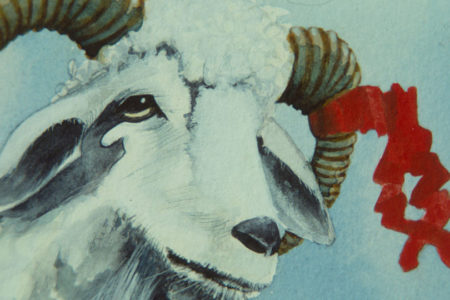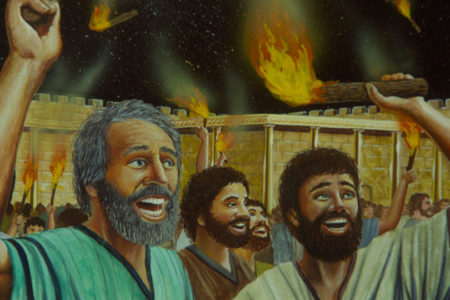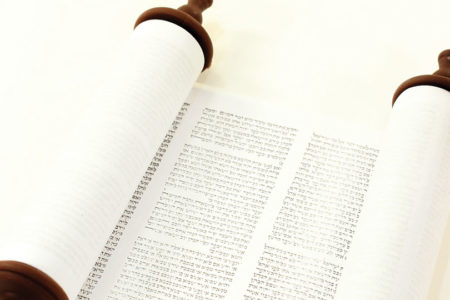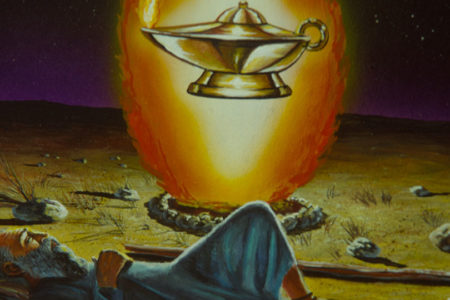Yom Kippur
It is the most awesome day of the Jewish year. Yom Kippur is the Hebrew phrase for the Day of Atonement. For more than 3,000 years, Jewish people have observed this annual day of solemn reflection and repentance. The date on the Jewish calendar is Tishri 10, usually falling in late September or early October. Although it is nearly universally observed in Jewish communities, this holy day has undergone a number of transformations in its history.
Yom Kippur in the Bible
As the sixth in the cycle of seven annual festivals, Yom Kippur is briefly described in Leviticus 23:26–32 and 25:8–12. Because of the supreme importance of the day, however, an entire chapter (Lev. 16) is devoted to describing the intricate details of its observance. The elaborate procedures given for that special day are as follows: (1) The high priest removed his regular garments, washed himself at the laver, went into the holy place, and put on special linen garments for the remainder of the service (Lev. 16:4). A common misconception is that he wore the elaborate garments with the breastplate, etc., but the text plainly states that his special garments for that day were very simple. (2) He then went out to sacrifice a bull at the altar of burnt offering for himself and the other priests (Lev. 16:11; cp. Heb. 9). (3) He then entered the Holy of Holies for the first time with some of the bull’s blood, along with incense and coals from the altar. The smoke from the burning incense hid the Ark of the Covenant from view as he sprinkled the blood on and in front of the Mercy Seat covering the Ark (Lev. 16:12–14). (4) He then went outside the Tabernacle and cast lots for two goats to see which one was to be sacrificed (Lev. 16:7–8). (5) At the altar, he killed the goat as a sin offering for the people and, for a second time, entered the Holy of Holies to sprinkle the blood in front of and on the Mercy Seat and also in the Holy Place (Lev. 16:5, 9, 15–16). (6) He then went outside to the altar of burnt offering and sprinkled it—with the blood of the bull for himself and the blood of the goat for the people (Lev. 16:11, 15). (7) While in the courtyard, he laid both hands on the second goat, thus symbolizing the transfer of Israel’s sin, and sent it away into the wilderness (Lev. 16:20–22). (8) The high priest then entered the Holy Place, removed his special garments, bathed, and put on his regular, ornate garments (Lev. 16:23–24). (9) As a final sacrifice, he offered a ram for himself and another ram for the people (Lev. 16:24). (10) The conclusion of the day was the removal of the sacrificial carcasses to a place outside the camp where they were burned (Lev. 16:27–28).
It is appropriate to inquire why there was a need for this day when an elaborate ritual of sacrifices for sins had already been prescribed in Leviticus 1–7. The answer lies in understanding the distinction between unintentional and intentional sins. The Pentateuch actually teaches that the regular sacrificial system covered unintentional sins only. The texts call them sins of ignorance (Lev. 42, 13, 22, 27; 5:15, 18; Num. 15:24–29). Numbers 15:30–31, however, declares that intentional sins (lit., those done with a high hand) were not covered by the regular sacrifices: “But the soul that doeth anything presumptuously, whether he is born in the land, or a sojourner, the same reproacheth the Lᴏʀᴅ; and that soul shall be cut off from among his people. Because he hath despised the word of the Lᴏʀᴅ, and hath broken his commandment, that soul shall utterly be cut off; his iniquity shall be upon him.”
On the Day of Atonement, the animal, as specifically stated in Leviticus 16:16, was sacrificed “because of the uncleanness of the children of Israel, and because of their transgressions in all their sins” (lit., whatever their sins have been). Note also the all-inclusive language used in Leviticus 16:21: “And Aaron shall lay both his hands upon the head of the live goat, and confess over it all the iniquities of the children of Israel, and all their transgressions in all their sins, putting them upon the head of the goat, and shall send it away by the hand of a fit man into the wilderness.” Thus, provision was made in the complete sacrificial system for atonement of both unintentional and willful sins. The unintentional sins were covered by the sin and burnt offerings. The intentional sins were covered by the Day of Atonement offerings.
Yom Kippur in the Second Temple
It should be remembered that the ritual described in Leviticus 16 was intended for use in the Tabernacle, that portable sanctuary of Israel in the wilderness and, later, in Shiloh during the first few hundred years of the people’s history after Sinai. With the construction of Solomon’s Temple in the tenth century B.C., the ceremony was adapted to the permanent surroundings of the Temple. We are not informed how the service was conducted in the Temple, so we must assume that it was conducted basically as it was in the Tabernacle.
With the construction of Zerubbabel’s Temple, and in Herod’s later embellishment of that Temple, certain customs were added to the Yom Kippur observance. This was the Temple that existed in Jesus’ day. There is a tractate in the Talmud called YOMA that describes the detailed ritual and some new customs associated with it.
Sadly, we are informed by Josephus, the Jewish historian, that the Roman procurators often appointed the high priests, thus encouraging corruption and bribery. Therefore, many were not spiritually minded men and were often ignorant of the teachings of Leviticus regarding their role. Consequently, the high priest often had to be instructed by a Temple priest regarding his duties on the coming Day of Atonement.
Furthermore, there is a rabbinic reference to the custom of tying a red thread to the horn of the second, live goat. It was believed that if God accepted Israel’s sacrifice on the Day of Atonement, the red thread would miraculously turn white as the goat was led away. We have no way of knowing whether or not this actually occurred. It is interesting, however, that later rabbis admitted that for the 40 years prior to the destruction of the Temple, the thread never once turned white! This tradition grows in fascination when we recall that most scholars date the Messiah’s crucifixion around 30 A.D., 40 years before the Temple’s destruction in 70 A.D.
Another custom observed in the Second Temple was that of pushing the live goat over a cliff to its death a few miles south of Jerusalem, after it was led away. This custom was to avoid the perplexing problem of what to do if the live goat wandered back from the wilderness.
In this regard, another belief became attached to the goat. Instead of being called scapegoat, the goat was called Azazel after its Hebrew name. Thus, a literal reading of Leviticus 16:8 is, “And Aaron shall cast lots upon the two goats: one lot for the LORD, and the other lot for Azazel.” This name was viewed as a title for Satan or one of his demons. (In modern Hebrew, when someone desires to curse another, he says, lech lazazel—go to Azazel!) Thus, the goat carried Israel’s sins, already expiated by the first goat, to Satan in the wilderness as evidence that he had no more cause to accuse Israel. For further discussion of this fascinating concept, the reader is encouraged to consult Dr. David Cooper’s excellent book What Men Must Believe, J. H. Kurtz’s Sacrificial Worship of the Old Testament, or S. H. Kellogg’s Commentary on Leviticus.
Yom Kippur Today
With the destruction of the Temple in 70 A.D., almost all of the Yom Kippur observance became impossible to carry out. To rescue from oblivion this and other observances that were so clearly tied to the Temple, the rabbis instituted radical changes in their observance. Yohanan ben Zakkai a first-century Jewish leader, declared that God no longer desired blood sacrifices but, in their place, accepted repentance, charity, and prayer. On this basis, Yom Kippur was transformed into a solemn day of introspection, prayer, and fasting.
This is the one day of the year when a complete fast from sundown to sundown is observed. Small children, pregnant women, and the infirm are exempt. Actually, the Bible does not clearly teach this commonly accepted practice of fasting on Yom Kippur. Leviticus 16:29 says, “ye shall afflict your souls,” which is interpreted by the rabbis as a command to fast. Nevertheless, even the most secular Jewish person usually participates in this solemn day by not working.
The service in the synagogue begins at sundown with the Kol Nidrei (all vows) prayer and continues with much liturgy and prayers for forgiveness. The Book of Jonah is read in the service, since the Ninevites fasted and repented as a result of his preaching (Jon. 3:5–10).
A folk custom arose in the Middle Ages called Kapporot. It is practiced today only by ultra-orthodox Jews. On the afternoon before the beginning of Yom Kippur, the person waves a chicken over his head and pronounces a prayer asking God to accept the death of the animal as an atonement for his sins. While this practice is not approved by the rabbis, the custom does reflect the burden of the Jewish heart that still recognizes the truth of Leviticus 17:11, “it is the blood that maketh an atonement for the soul.”
With all of its solemnity and ritual, the observance of Yom Kippur does not result in the assurance that sins have been forgiven. Many Jewish people testify that they still lack a confident sense of peace at the end of the day.
Yom Kippur in Prophecy
The reason why the Day of Atonement could never provide a lasting answer to the problem of sin lies in the simple fact that it had to be repeated year after year. The writer of the Epistle to the Hebrews eloquently stated the problem: “For the law, having a shadow of good things to come and not the very image of the things, can never with those sacrifices which they offered year by year continually make those who come to it perfect. For then would they not have ceased to be offered? Because the worshipers once purged should have had no more consciousness of sins. But in those sacrifices there is a remembrance again made of sins every year” (Heb. 10:1–3). The purpose of the annual, national sacrifice on Yom Kippur was to roll forward the sins of Israel one year. No sacrifice was observed, however, that could roll away sins forever.
But the writer also declared that the sin question had to be solved, and it was solved by the Messiah’s work of atonement. “For Christ is not entered into the holy places made with hands, which are the figures of the true, but into heaven itself, now to appear in the presence of God for us; Nor yet that he should offer himself often, as the high priest entereth into the holy place every year with blood of others; For then must he often have suffered since the foundation of the world. But now once, in the end of the ages, hath he appeared to put away sin by the sacrifice of himself” (Heb. 9:24–26). Thus, the Messiah came to put away sins once for all. In so doing, He opened the approach to God whereby we may come by faith and be acceptable to Him, “By which will we are sanctified through the offering of the body of Jesus Christ once for all” (Heb. 10:10).
But what of national Israel? Is there no place in the prophetic plan of God for the future fulfillment of a national Yom Kippur? God’s Word is clear, both in the Old and New Testaments, that a national day of salvation awaits the Jewish remnant that survives the Tribulation period. Zechariah described a day when the Jewish people will look to the pierced one in the mourning of repentance (Zech. 12:10–13:1). Paul stated, “And so all Israel shall be saved; as it is written, There shall come out of Zion the Deliverer, and shall turn away ungodliness from Jacob; For this is my covenant unto them, when I shall take away their sins” (Rom. 11:26–27). God also declared through Zechariah, “I will remove the iniquity of that land in one day” (Zech. 3:9).
Just as Passover, Unleavened Bread, First Fruits, and Pentecost prophetically pictured the First Coming of the Messiah, so Trumpets, the Day of Atonement, and Tabernacles prophetically picture events associated with the Second Coming of the Messiah. Israel’s final Yom Kippur will result in the nation’s accepting the one true atonement, which was effected through the Messiah’s sacrificial death.
Never in her long history has Israel merited God’s forgiveness. When they accept the sacrifice of Jesus, however, the prophets’ visions will finally be realized, “for they shall all know me, from the least of them unto the greatest of them, saith the Lᴏʀᴅ; for I will forgive their iniquity, and I will remember their sin no more” (Jer. 31:34b).








